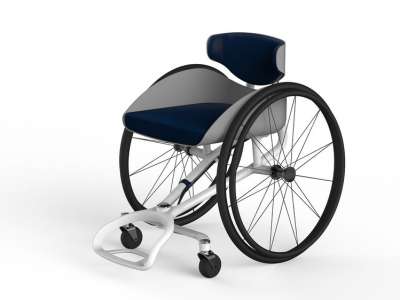
Reto Togni is a Swiss designer who studied at Zurich University of the Arts, the Royal College of Art (London), and Imperial College London. At the PMG Conference 2018 in Manchester, he presented about the prototype for his Reagiro manual wheelchair (design pictured) and used the opportunity to explain the progression from original idea to prototype.
The Reagiro is the first manual wheelchair to feature a fully mechanical steering system which allows the user to control the wheelchair through upper body movements rather than the conventional method of powering a wheelchair. Togni feels that the benefits to this method of powering a wheelchair are:
- that the user can mobilise the wheelchair one handed, allowing them to carry items in their free hand
- that the use of lateral movements to power the wheelchair is connected to fun and a sense of freedom
He had concluded that, although there have been many advances within the world of assistive technologies, there has been very little development of manual wheelchairs over recent decades; this is what inspired him to develop the Reagiro.
Togni showed us how the prototype for the Reagiro had developed from early wood and metal static prototypes to the fully working model; he also told us that he's started working with Invacare and the Zurich Lab for Biomechanics to develop the wheelchair further. The next phase is to create a research plan for clinical usability studies and trialling.
It was a very interesting session documenting the development of a manual wheelchair from a design perspective, rather than a wheelchair which had been developed to meet the clinical needs of wheelchair users.
As an occupational therapist in an NHS wheelchair service, I find that one of the main issues highlighted by our wheelchair users is the weight of the wheelchair; followed nowadays by what are the potential and comparative costs if they are purchasing a wheelchair through a personal wheelchair budget. It would have been interesting to know how the Reagiro might compete with currently prescribed wheelchairs in both these respects.
Because a 3D printer is used to manufacture its core components, a potential benefit of the Reagiro is that it could be made to fit the individual’s needs, in effect providing a bespoke wheelchair. I will be curious to hear the results of the clinical trials; it will also be interesting to see how the Reagiro is received by wheelchair users, and how that might lead to further developments. However, regardless of how far the development goes, it is heartening to find inventors who are looking at alternative designs for wheelchairs, and using innovative manufacturing techniques.
References
Togni, R. 2017. The Reagiro [online]. Available at: https://retotogni.com/the-reagiro [Accessed 12 September 2018]
Global Grad Show. 2018. Meet the Designers [online]. Available at: http://www.globalgradshow.com/projects/the-reagiro/ [Accessed 13 September 2018]






.jpg)



no comments
Add your comment...